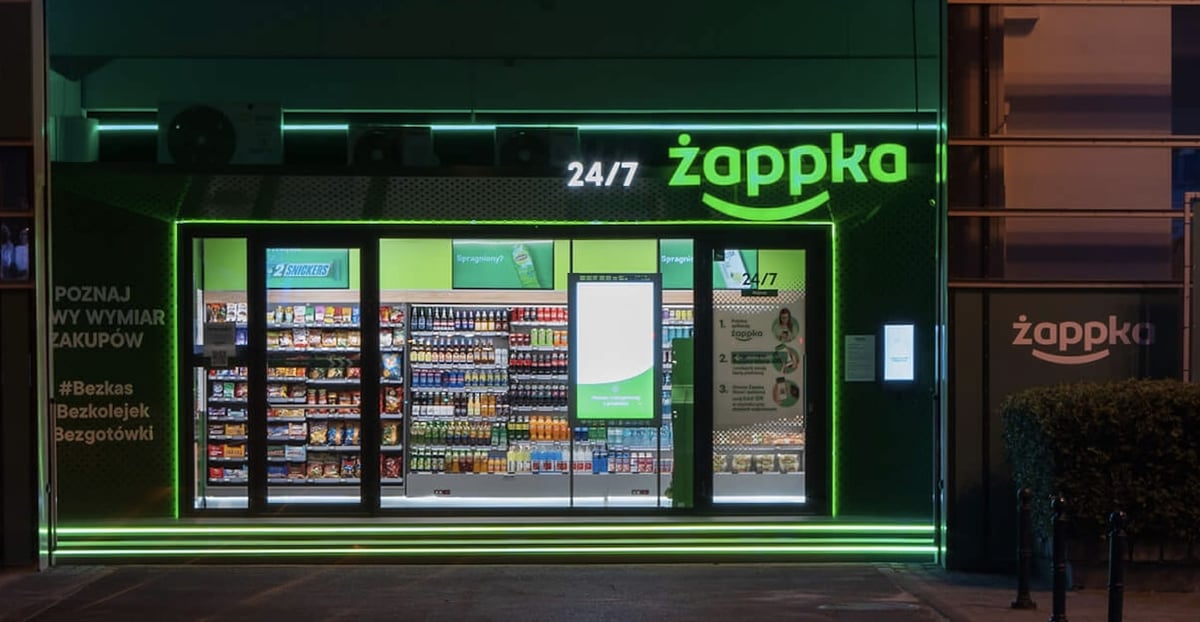Innovating Faster Than Amazon: Exemplary Digital Acceleration By Żabka

Żabka is a leader in the convenience sector. From a franchiser of small brick-and-mortar shops in 1998, it’s now a technology-driven powerhouse able to expand checkout-free shops faster than Amazon.
When I look at Żabka, I see that they don’t just respond to customer demands – they own the change and proactively shape their business environment.
Leading the market by owning the change
In a recent interview for McKinsey & Company, Żabka’s managing director, Adam Manikowski, noted that “time is becoming the new currency.” Saving time for customers is the biggest driver of innovation in the convenience sector.
Amazon obviously comes to mind. Currently planning to roll out drone deliveries by the end of 2022 (after a decade of developing this concept), they promoted their autonomous, no-checkout, Amazon Go store concept back in 2016. Developed alongside their Amazon Fresh stores, it was a somewhat unexpected move for the digital-first ecommerce behemoth to venture into brick-and-mortar grocery shops.
Żabka was in the reverse situation. As a leading brick-and-mortar store franchise, they decided to evolve digitally to stay on top of the market.
So, also in 2016, Żabka engaged in digital transformation.
They started using technology to directly drive growth. They built an AI system that helped them open new store locations faster. They became data-driven. They started the Żabka Future unit, focused exclusively on innovative projects, which currently represents 15% of the entire Żabka workforce.
Meanwhile, between 2016 and now, Amazon Go stalled. The first store was opened in 2018, with a plan for 3,000 more in the US by 2021 – only 24 actually opened, accompanied by 38 cashierless Amazon Fresh stores across the US and UK.
What about the competition? In their press release, 7-Eleven inform that they recently rolled out their ninth Evolution store with delivery and checkout through their mobile app. In Germany, supermarket chain REWE has just opened their second autonomous grocery store. Similar small-scale rollouts can be seen across the globe.
Żabka, on the other hand, is already leading the race even though it has just started. In June 2021, they opened the first autonomous Żabka Nano store.
As of July 2022, they already have 50 operating locations. By far, they have dominated the autonomous store market in Europe, outpacing all competitors.
Żabka Nano has no baskets, no cashiers, and no counters. You enter using the Żappka app or a payment card, take what you want, and leave. All this thanks to AI-powered computer vision and a smorgasbord of other systems working in tandem to make the shopping experience completely frictionless.
How did they make this happen? It was the direct result of the long-term commitment of Żabka’s management to innovation, speed, and digital resilience in their business. In other words, a commitment to digital acceleration.
Long-term thinking and true commitment to the future
To succeed at digital acceleration like Żabka, on the one hand, you need to move fast on a daily basis and produce deliverables quickly.
On the other hand, you need to maintain a broad outlook of the project to never lose sight of which stage you’re at, and what the main priorities of that stage are.
Simply put, you need to move fast without losing track of long-term goals. I see three main ingredients that enable this:
- Long-term thinking and broad perspective
- Digital acceleration as an explorative journey, not a pre-defined plan
- Development guided by product life cycle
Allow me to explain:
1. Long-term thinking and broad perspective
In Żabka’s project, our team was in charge of creating the engine for multiple complex systems to work as one ecosystem. Product scanning, frictionless payments, image recognition, automatic doors, telemetry, movement sensors, and more – all of this had to be morphed into one scalable, cloud-based backbone for autonomous stores.
That’s a lot of elements, and each of them came with a list of expectations that were subject to change over time. Had we gotten stuck for too long on any individual element, the whole project would have stalled.
In such an environment, long-term thinking becomes critical.
You need to keep track of project goals (and their respective KPIs), test their validity, and suggest alternatives if necessary.
It’s the main way to ensure that key project stakeholders are on the same page at all times. If they’re not, the volatile project environment can quickly breed frustration.
There’s also a macro aspect to long-term thinking, which is that you don’t expect ROI from the project to materialize immediately. You’re building new streams of revenue that might fully come into fruition in a few years, while at the same time protecting your business from becoming obsolete.
A digital acceleration project is like a journey. You know your destination and the general direction you need to travel in, but you’ll have to make countless small decisions and adjustments along the way which might lead you to places that you never even imagined.
2. Digital acceleration as an explorative journey, not a pre-defined plan
Having worked at Netguru for over ten years, I’ve had front row seats to watch how agile methodologies have infiltrated and dominated the IT industry.
But methodologies aren’t everything – they need to be preceded by a change in mindset.
One of the most dangerous mindsets is treating initial project assumptions as set in stone (as opposed to testable assumptions that need to be verified).
Few digital products are ever built in a linear fashion. Market leaders know that innovation involves a lot of exploration, where many explored paths turn out to be dead ends.
Reaching a dead end is no reason to be discouraged – you’re actually gaining precious insight about what to avoid.
Plus, not all dead ends are alike, which might be the trickiest part of this exploration. If you’re unfortunate, you might end up dismissing a good product if consumers aren’t enthusiastic about it at first. It can be hard to tell if consumers don’t like your idea, or if they just need more time to understand it.
The secret to productive and profitable exploration is a mindset of fast experimentation and continuous user and market testing.
Thinking about the essence of exploration, the classic Steve Jobs saying comes to mind:
“You can't connect the dots looking forward; you can only connect them looking backwards.”
To switch from ironclad planning to exploration, you need to adopt a mindset of continuous and simultaneous:
- Decision-making
- Discovery
- Delivery
The first version of the product will be incomplete in many regards – but this version is only one, necessary step towards finding the perfect market fit.
In successful digital acceleration projects, assumptions are tested quickly, iteration cycles are short, and customer feedback is collected earlier, all of which leads to achieving market fit sooner.
My colleague Hubert, Lead Project Manager at Netguru, described it nicely when we were discussing this topic: “With digital acceleration, the first phase of the project is always uncertain. The way through that uncertainty is to fail fast, and swiftly adapt to the ever-evolving context of the project.”
3. Development through the lens of product life cycle
Where do most misunderstandings and unnecessary costs come from? I’ve been involved in product development long enough to see that lack of compromise plays a huge part here.
Either the business perspective overpowers the product development point of view, or the other way around. Sometimes, there’s a third factor that meddles with both perspectives – changes in the project environment. In retail especially, a sudden shift in legislation or work costs can completely derail the development roadmap.
To succeed at digital acceleration you simply must seek compromise between these worlds, on a daily basis, from start to finish.
The way to find this compromise is to view projects through the lens of the product life cycle:
- No decision happens in isolation, it will impact other parts of the project over time.
- Development priorities change dramatically between initial project stages and every following stage.
- Too much investment in polishing every little part of the product early on generates the risk of burning through the budget before the product is delivered.
Courage to transform customer behaviors
Leaders like Żabka are paving the way toward the future. It’s not just because they’re savvy or benefit from economies of scale.
It’s because they’re committed to owning the change in their sector, boldly investing in innovation, and – most importantly – they’re able to make rapid decisions and adjust their plans in line with customer expectations.
And that is the very essence of how digital acceleration is done.


